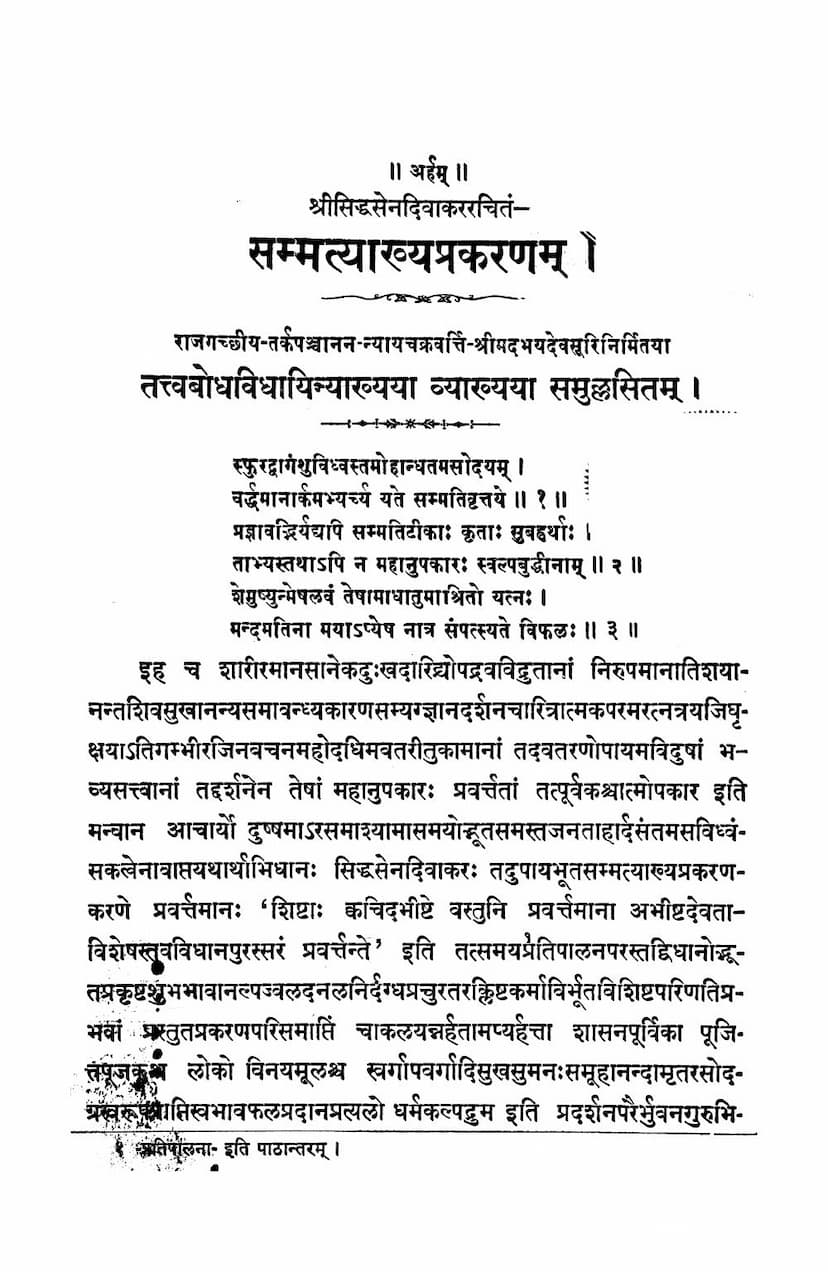Sammatyakhya Prakaranam
Added to library: September 2, 2025

Summary
This is a comprehensive summary of the Jain text "Sammatyakhyā Prakaranam" by Siddhasen Divakara, as presented in the provided pages, along with the commentary "Tattvabodha Vidhayini."
Core Subject and Purpose:
The "Sammatyakhyā Prakaranam" is a foundational Jain philosophical text authored by Siddhasen Divakara, with a significant commentary by Abhayadeva Suri. Its primary goal is to explain and establish the validity of the Jain path to liberation, embodied by the "three jewels" (Ratnatraya) of right knowledge (Samyak Jnana), right faith (Samyak Darshana), and right conduct (Samyak Charitra). The text aims to guide individuals, especially those with limited intellect, towards understanding and embracing these essential principles.
Central Argument: The Self-Validity of Knowledge (Svatḥ Pramāṇyam)
A significant portion of the text is dedicated to a detailed philosophical debate on the nature of knowledge and its validity, primarily engaging with the Mimamsa school's view of parataḥ pramāṇyam (pramanic validity derived from external factors). The Jain perspective, as presented here, strongly advocates for svataḥ pramāṇyam (self-validity of pramanas).
- Mimamsa View (Parataḥ Pramāṇyam): The Mimamsa school argues that the validity of knowledge (pramāṇya) is not inherent. It depends on external factors related to its origin (utpatti), function (svakārya), and ascertainment (jñapti). They contend that any claim of self-validity is flawed because knowledge requires additional factors to be considered valid.
- Jain Counter-Argument (Svataḥ Pramāṇyam): Siddhasen Divakara, through the commentary, systematically refutes the Mimamsa position. The core of the Jain argument is that knowledge, by its very nature, is valid and self-illuminating.
- Origin (Utpatti): The text argues that knowledge does not require external qualities or factors beyond its own causal conditions to arise validly. It critiques the idea that sensory faculties (like eyes) need additional qualities to perceive correctly, or that inferential knowledge relies on external factors beyond the inherent relationship between the middle term (linga) and the major term (sādhya). The concept of svabhāvahetu (reason based on inherent nature) is invoked to support this.
- Function (Svakārya): The text asserts that when knowledge is applied to its function (e.g., discerning reality), it does so independently of external validation. The circular reasoning of needing knowledge to validate knowledge is exposed.
- Ascertainment (Jñapti): The validity of knowledge is not dependent on subsequent ascertainment through other means. Doubt or error are presented as deviations, not the norm, and the inherent nature of knowledge is to be true. The text argues that the mind naturally ascertains reality without needing further external confirmation for every piece of knowledge.
Key Concepts and Refutations:
- Pratyaksha (Perception) and Anumana (Inference): The text elaborates on how perception and inference, when properly understood within the Jain framework, are inherently valid. It critiques arguments that try to undermine their directness and self-sufficiency.
- Theories of Validity (Svatoh and Paratah Pramanyavada): The entire debate revolves around these two opposing views, with the Jain side championing the inherent validity of knowledge.
- Causality (Kārya-kāraṇa Bhāva): The validity of knowledge is seen as intrinsically linked to its causal conditions, but the Jain argument emphasizes that the validity itself is not an additional causal factor.
- The Role of Doubt and Error: Doubt and error are discussed as exceptions or deviations from the norm of valid cognition, rather than defining characteristics that necessitate external validation.
- The Self-Illuminating Nature of Knowledge: The text implies that knowledge itself is the illuminator of reality and its own validity, much like light illuminates itself and its surroundings.
- Critique of Cyclic Reasoning (Chakrakaloka Dūṣaṇa): The Mimamsa argument for external validation is often presented as a circular dependency, where knowledge requires validation, and the validating knowledge itself requires further validation, leading to an infinite regress. This is a key point of refutation for the Jain scholars.
- The Meaning of "Shasana" (Doctrine/Discipline): The Jain doctrine (Shasana) is described as being well-established (Siddha Pratishthita) and possessing intrinsic authority, not needing external validation from this specific text. It's described as the twelfth limb of Jain scripture, providing a clear framework for understanding reality.
- The "Jinas" (Victors): The text refers to the Jinas (founders of Jainism) as those who have attained ultimate states of happiness. Their doctrine is considered self-valid.
- The Nature of "Stava" (Praise): The act of praise (stava) is defined as the expression of one's own inherent qualities, especially in the context of acknowledging the perfection of the Jinas.
Refutation of Other Philosophical Positions:
The text engages with and refutes other philosophical viewpoints, including those that might introduce external validation or undermine the inherent nature of Jain principles. This includes discussions that touch upon:
- The nature of perception and its relationship to external reality.
- The role of intention and cause in the validity of knowledge.
- The arguments of Buddhist philosophers (Saugatas) and others.
- The concept of "apaurusheyatva" (being non-authored or divine) in relation to scriptures, which is debated in the context of Vedic texts and potentially applied to Jain scriptures.
The Commentary's Role:
Abhayadeva Suri's commentary, "Tattvabodha Vidhayini," is crucial for unfolding the complex philosophical arguments of Siddhasen Divakara. It clarifies the intricate reasoning, dissects opposing arguments, and provides detailed explanations for each proposition, ensuring a thorough understanding of the Jain doctrine of self-validity. The commentary's exhaustive nature highlights the depth of Jain epistemology.
Overall Significance:
The "Sammatyakhyā Prakaranam," through its rigorous philosophical exposition and detailed refutations, aims to equip the reader with a clear and confident understanding of the Jain path. By establishing the self-validity of its core principles, it empowers individuals to embrace the Ratnatraya as the direct means to liberation, free from reliance on external or uncertain justifications. The text is a testament to the intellectual sophistication of Jain philosophy, particularly in the realm of epistemology and metaphysics.